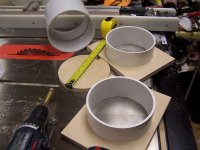Barrel Saver
New member
Finally, after off & on 5 year build I'm hooking up my CV MAX.
By now some of you must know the smart way to step or taper down from the 6" main pvc pipe to connect a table saw. Is the Kanaduct hose that you twist to taper down a good solution or is it smarter to use the Fernco Flexible Rubber Couplings with regular straight flex hose???
Suggestions welcomed. Thanks in advance! TK
By now some of you must know the smart way to step or taper down from the 6" main pvc pipe to connect a table saw. Is the Kanaduct hose that you twist to taper down a good solution or is it smarter to use the Fernco Flexible Rubber Couplings with regular straight flex hose???
Suggestions welcomed. Thanks in advance! TK

